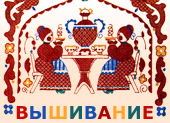
Introduction
The Hermitage Museum in Leningrad boasts one of the richest and most important collections of Russian embroideries in the Soviet Union. It comprises several thousands of embroidered clothes, headdresses, objects of interior decoration and ecclesiastical pieces as well as a great many details thereof. The collection provides an illuminating insight into the creative work of Russian needlewomen from different layers of the population. The most noteworthy of its items include extraordinarily refined works by urban masters, embroideries made by serfs in the monasteries or produced by artisans in various centres and workshops. Numerous folk embroideries demonstrate the distinctive features of peasant craftsmanship. The purpose of this album is to acquaint the reader with the most artistically valuable pieces of the Hermitage collection typical of one period or another. Most of these are published for the first time.
Embroidery is one of the most popular forms of needlecraft designed for the ornamentation of fabrics. The decoration of clothes and furnishings with embroidered patterns has been practised in Russia from the earliest times. Eighteenth century Russian embroidery represented a well-developed form of applied art distinguished by diverse complex techniques and multifarious ornamental and thematic designs. The eighteenth century was a turning point in the history of Russian embroidery. The daily life of the ruling classes and townspeople changed radically under the influence of Western European culture. This, in turn, led to the emergence of new types of embroidery which made use of bugles and beads, coloured and white satin stitch, cross stitch, etc.
Transplanted onto Russian soil, Western European embroidery acquired essentially new forms and a new, national, character. The gold embroidery and trimming with pearls that had been so much in vogue in Russia also underwent substantial changes. Their repertory of ornaments was now governed by the dominant artistic trends of the period, and the techniques of execution were modified. Subsequently, throughout the entire nineteenth century, more and more layers of the urban population and even the peasantry became attracted to the Western European type of embroidery. The flourishing of the art of embroidery in Russia falls into the late eighteenth - first half of the nineteenth centuries, i. e. a period when high-quality works were produced in great numbers. After a certain decline in the second half of the nineteenth century, needlework both in towns and villages experienced a revival in the late nineteenth and early twentieth centuries in the techniques and materials characteristic of the time.
As is well known, folk embroidery makes a persistent use of traditional ornamental motifs and devices. The impact of the culture of nobles and townspeople could not break the already crystallized norms of style inherent in folk embroidery. It only complemented the latter with a new range of patterns and devices. This album shows the remarkable versatility of Russian peasant needlewomen, their most favoured techniques and designs.
The question of the manufacture of most needlework forms used by the nobility and townspeople has scarcely been studied until now. The information provided in this album is essentially an attempt at locating the possible centres, workshops or sectors of the population which played an eminent role in the creation of Russian artistic embroidery.
|
ПОИСК:
|
© STEGHOK.RU, 2013-2020
При использовании материалов сайта активная ссылка обязательна:
http://steghok.ru/ 'Вышивание'
При использовании материалов сайта активная ссылка обязательна:
http://steghok.ru/ 'Вышивание'